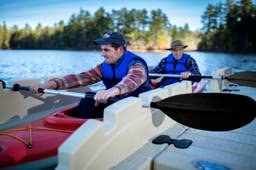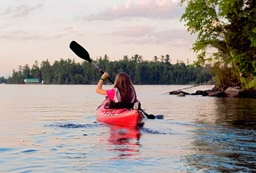
There are as many reasons to paddle as there are lakes to paddle on. Fishing, bird-watching, exploring and spending time with someone close to you may come to mind.
At the top of the list you probably haven’t included paddling for exercise. But paddling a canoe or kayak definitely provides fitness benefits, even though walking, running and bicycling are more common paths to fitness.
And this is not an either/or proposition. According to Richard Cotton, chief exercise physiologist for myexerciseplan.com and a spokesperson for the American Council on Exercise, canoeing is a great complement to walking, jogging and cycling because it works the upper body.
So now you have a great excuse to grab the canoe paddle following your morning hike through the woods. But how do you paddle for exercise?
At the top of the list you probably haven’t included paddling for exercise. But paddling a canoe or kayak definitely provides fitness benefits, even though walking, running and bicycling are more common paths to fitness.
And this is not an either/or proposition. According to Richard Cotton, chief exercise physiologist for myexerciseplan.com and a spokesperson for the American Council on Exercise, canoeing is a great complement to walking, jogging and cycling because it works the upper body.
So now you have a great excuse to grab the canoe paddle following your morning hike through the woods. But how do you paddle for exercise?
See also The Best Life Jackets for Dogs
Easy or Hard?
Paddling cadences can be used to create different exercise programs. Cotton advises people to listen to their body’s reaction to the effort. His motto: As long as you feel like you’re getting some exercise, you are getting some exercise.
A steady paddle is typically classified as moderate activity – like brisk walking or casual cycling – and can burn an estimated 174 calories during an hour.
If you are paddling hard, on the other hand, that could be considered a more vigorous, high-intensity workout. According to exercise physiologists, vigorous activities are those that burn over 350 calories per hour.
Instead of just paddling steady or hard as you tour your lake, consider changing cadence speeds. You can mix it up with interval paddling – easy, hard, easy, hard – to give it some variety. That’s a great way to begin if you’re not in great paddling shape. “Go out, take it easy, and for a minute or two push a little bit, and then ease up. It never has to be uncomfortable. We’re not training for the Olympics,” Cotton advises.
A steady paddle is typically classified as moderate activity – like brisk walking or casual cycling – and can burn an estimated 174 calories during an hour.
If you are paddling hard, on the other hand, that could be considered a more vigorous, high-intensity workout. According to exercise physiologists, vigorous activities are those that burn over 350 calories per hour.
Instead of just paddling steady or hard as you tour your lake, consider changing cadence speeds. You can mix it up with interval paddling – easy, hard, easy, hard – to give it some variety. That’s a great way to begin if you’re not in great paddling shape. “Go out, take it easy, and for a minute or two push a little bit, and then ease up. It never has to be uncomfortable. We’re not training for the Olympics,” Cotton advises.
How Long, How Often?
The kids want to go fishing, and the deck needs a coat of stain. So you’re wondering if you have time for canoeing. “The research has been showing that even short segments give benefits,” Cotton says. Twenty minutes is a nice minimum. If it’s more moderate activity you’re looking for, then 30 minutes or more is needed.In any fitness plan, the key to success is exercising on a consistent basis. It is, in fact, recommended that Americans engage in a half-hour or more of moderate physical activity on most days – preferably every day – according to the Food and Drug Administration’s dietary guidelines. If that amount of activity fits with your lifestyle, then canoeing can be one way to be, and stay, active. And that’s good news. Let’s face it, many of us will need a whole menu of exercise options to squeeze in 30 minutes of exercise seven days a week! So why not do something you enjoy for your exercise?
We’ve all heard it, but it bears repeating (especially for the weekend warriors among us): to ward off injury in any sport, it’s important to start out slowly. Just because you’re in reasonably good, all-around shape doesn’t mean you’re in great shape for paddling. Start off doing it for a comfortable length of time at a comfortable pace.
See also Your Spring Boat Check List
It’s All About Technique
Maintaining proper paddling technique also is important in order to avoid injuries. Hand anyone a paddle and he/she will be able to move the canoe forward with a single stroke. But just because the paddler achieves the desired effect doesn’t necessarily mean it has been accomplished in the right way.
Any paddler will tell you the hardest part of canoeing is making the canoe go straight. Every paddle stroke will cause the boat to veer away from it. You have to do something to correct that at the end of the stroke. The familiar J-stroke is an example of a correction stroke. All of these correction strokes have to be done efficiently or they rob you of your forward momentum.
For fitness paddling, Gordon Black – director of safety, education and training for the American Canoe Association – advises using a technique called sit-and-switch. Paddle a few strokes on one side then switch to the other side until the boat begins to veer, then you switch back to the other side. In effect you steer with forward strokes, he explains.
Black recommends using a bent-shaft paddle for the sit-and-switch technique. And, he says, buy the lightest you can afford. While you can get a great workout with a $15 paddle or a $200 paddle, you will go faster, last longer and have more fun with a nicer, lighter paddle.
Biomechanics
Black advises that you “reach way forward and keep the blade close to the boat.” In doing so, you will feel your torso get involved in the workout. The muscles of the abdomen and lower back are key to paddling effectively. “If you rotate your torso so you are reaching very far – almost uncomfortably far forward to begin a canoe stroke – you wind your body up like a big spring. The propulsion part of the stroke is really an unwinding action of your tensed torso,” explains Black.
The tendency is to rely too much on the shoulders to provide paddling power.
“You end up using your biceps too much and it wears you out too fast. It’s a great way to build up your biceps but it’s not an efficient way to propel a canoe. If you can rotate lower down and incorporate your torso, you get more power and much more endurance,” Black says.
Since it’s a major component of the paddling stroke, your shoulder is vulnerable to strain and stress. Little mistakes in your balance that cause you to catch the weight of your body on your shoulder can cause problems. Making sure your shoulder is warmed up is key, Black says. One way to warm up your shoulder is, again, to start each canoe outing at a slower pace.
See also The Top 9 U.S. National Park Hikes
If you’re enamored with paddling and plan to do some serious canoeing, the best way to improve your technique is to take a training class. Books and videos are available with good information, but they can’t provide personal attention.
“An instructor can watch you and tell you what your biomechanical issues are. We’re all different. You need that coaching,” says Black. “Feedback is huge. Canoeing lends itself to reinforcing mistakes. Most people getting into a canoe without any instruction will commit one of several mistakes. Feedback can help prevent that.”
Just how fast can you move across the water? According to Black, average recreational paddlers can move a 16- to 18-foot canoe between 4-7 miles per hour with a quick cadence.
Paddle to relax, paddle to get away from chores or paddle to improve your fitness level. Now you have another reason to get out and cover some water.
For more information:
• American Council on Exercise; www.acefitness.org• American Canoe Association; www.acanet.org
As a Boy Scout, Lou Dzierzak missed his first canoe instruction session because of kitchen duty. Later that day, when the instructor yelled “back paddle,” Lou turned the paddle around and used the handle to push away from the shore. The technique has not caught on with experienced paddlers.










